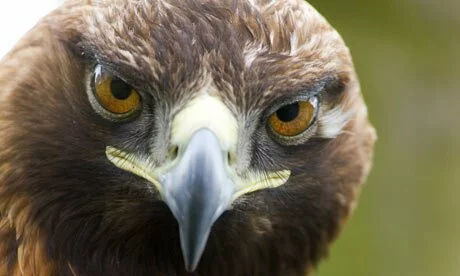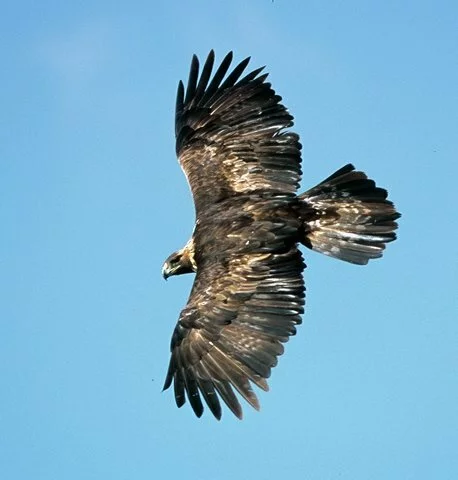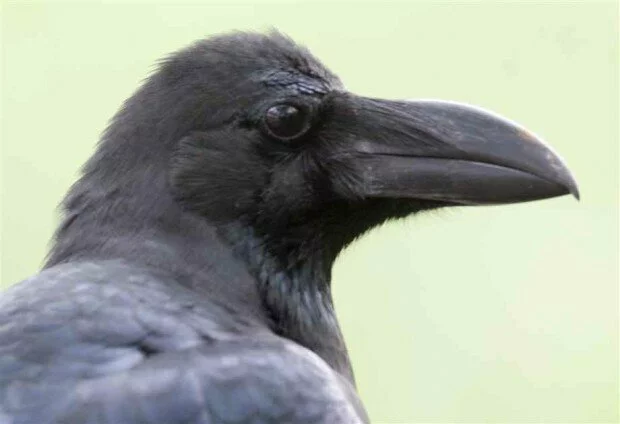The Golden Eagle: Apex Predator of the Skies
Renowned for their beauty, intellect, and strength, eagles are among the most popular of all animals. Due to their symbolic characteristics (representing both might and independence), they have been used as national symbols throughout history.[1] This respect originates from their nature as fierce hunters, capable of swiftly descending from the sky and overpowering their prey while also possessing the ability to lift nearly half of their weight during flight. Among the most magnificent of these birds is the golden eagle (Aquila chrysaetos). This impressive bird of prey (a bird with excellent eyesight, strong feet designed to grasp prey, and a beak fashioned for tearing flesh)[2] is among the largest of the eagles, and well known for its ability to attack and kill relatively large prey. It is a politically significant species, serving as Mexico’s national bird as well as the national identity for several other countries and polities.[3] It is also a bird of religious importance, venerated as a spiritual being in some cultures while serving a symbolic role in other faiths.[4] Yet it is in the wild where the golden eagle’s true powers are observed, in the realm where it fulfills its role as the apex predator of the skies.
The golden eagle is a very large bird possessing broad, rounded wings. Despite its common name, most of its body consists of a dark brown color. The name “golden eagle” originates from the coloration of the nape, which can vary from yellow to a dark golden hue. These birds can weigh up to 14 lbs and reach lengths of more than 3 feet. Their wingspans are especially remarkable, attaining lengths of 7 feet from tip to tip.[5] As a bird of prey, the golden eagle is designed for regularly hunting other animals. The eagle’s talons allow it to grasp and kill prey while its sharp, powerful beak makes tearing through flesh an easy task. With large eyes taking up most of the space in its head, the eagle possesses much greater vision than any human. These keen eyes allow the eagle to see clearly and in color. Even animals located a long distance from the eagle’s position are not safe from its telescopic vision. Although its large eyes can barely move in its eye sockets, the eagle can rotate its head nearly 270 degrees (much like an owl can) in order to scan its surroundings.[6] Overall, the golden eagle is a marvelously designed predator.
The golden eagle is the most widely distributed of all the eagle species, occurring throughout North America, Europe, North Africa, and Asia.[7] Like most other large birds which hunt from the air, the golden eagle prefers wide-open spaces, especially hilly and mountainous regions. These habitats allow the eagle to easily observe its environment from an elevated location for any signs of prey. In the United States, they are commonly found in rather dry habitats.[8] Although some golden eagles migrate during the winter (due to a lack of food during the season) or for breeding, others remain in their nesting territory year-round.[9]
Golden eagles reside at the top of the food chain. Due to the difficulty of successfully hunting an eagle, most large predators avoid targeting these birds. The eagle’s size and power allow it to hunt a wide variety of prey, including rabbits, marmots, ground squirrels, reptiles, fish, other birds, and sometimes even animals as large as full grown deer. Occasionally, the golden eagle will also feed on carrion.[10] The large birds usually try to pick out a weak, old, or sick animal to attack (this makes the hunt easier since the prey is less likely to fight back as aggressively as a healthy target). The eagles also tend to attack upwind, which results in increased speed and maneuverability for the eagle.[11] Once an animal is targeted, the eagle soars after it (generally attacking from a low level), using its boosted speed from the wind to its advantage. As the distance between the two animals diminishes, the eagle prepares its claws for the strike. If the attack is a success, the bird clutches the target in its talons and lifts the prey right off the ground or kills and consumes the animal on the spot. On rare occasions, the golden eagle will actually dive from the sky after its chosen prey item. The eagle can reach incredible speeds during these sky attacks, with estimates in the range of 150-200 miles per hour! These fierce speeds are comparable to the dive attacks of some of its smaller relatives, such as the peregrine falcon (Falco peregrinus). It is not uncommon for a pair of golden eagles to hunt cooperatively, either, which increases the chances of making a kill.[12] The combination of strategy, speed, and power makes the golden eagle a formidable predator and its hunts spectacles to watch.

Although golden eagles are generally silent animals, they emit mewing cries during mating season as they carry out courtship flights.[13] Eagles will begin to mate once they are about 4 years of age, and they usually remain with their partner for life.[14] They build their nests on cliffs, or occasionally on trees, so that the eggs remain safe from ground dwelling predators. The nests are quite large, averaging around 6 feet wide and 3 feet deep. Once the nest is complete, the female can finally lay her eggs (usually two, though a clutch of up to four eggs is possible). The female does not have to do much other than to incubate her eggs while her partner provides her with food (on occasions the male will also take over the incubating role). Once the fledglings finally hatch, both parents take the responsibility of providing them with food. The young birds take their first flight around 65-70 days after hatching, and they instinctively know how to hunt. However, many eagles do not survive their first year. This is due to the fact that they lack hunting experience and sometimes starve to death from a food deficiency.[15] A golden eagle that survives this early and difficult stage can grow to become one of its ecosystem’s top predators and look forward to a relatively long life of 30 years.[16]
Eagles, including golden eagles, are important animals in the spirituality of several different cultures and faiths. They are referenced in the Bible with varying symbolism. Exodus 19:4 compares the eagle’s care for its young to God’s care for humankind. In addition to this, Isaiah 40:31 uses eagles as models for strength.[17] References similar to these are found throughout the Biblical texts, in both the Old and New Testaments. Other cultures consider eagles to be spiritual beings. Cultures in the Northwestern coast of North America depict eagles in their ancestral totem poles, believing that the creatures possess spiritual properties.[18] Certain cultures recognize eagles as special creatures in other ways. In Mongolia, for instance, golden eagles have long been trained for falconry, an art and sport where the birds are trained to assist in hunting animals.[19] Whether these majestic animals are viewed from a spiritual, symbolic, or sporting perspective, it is clear that humans throughout history have recognized the golden eagle and its relatives as fascinating creatures.
However, humans are sometimes also a threat to the eagles. In the past years, thousands of golden eagles were killed because ranchers believed the large birds would prey on their young sheep and goats. The eagles were commonly shot from airplanes (an act which briefly became a popular sport). The killings continued until it was eventually discovered that the eagles were not, in fact, preying on domestic livestock. Unfortunately, many golden eagles are still killed for their feathers.[20] Although the species is not currently in danger of extinction, golden eagle population numbers may continue to decline in the future. This may prove detrimental to the environment, as apex predators such as eagles are vital in keeping the population numbers of other species under control, including animals which are considered pests.[21]
The golden eagle is an extraordinary bird of prey which is as beautiful as it is powerful. Throughout history, these stunning creatures have captivated the minds of countless people. Some cultures view them as spiritual creatures, while others see them as symbols of strength and justice. Whether admired for their beauty or their might, it is clear that these animals are superbly designed for survival in the wild, which they carry out with exceptional prowess.
[1] “Political Identities.” www.eagles.asu.edu. Available from http://eagles.asu.edu/eagles/Political/MainPol.html. Internet; accessed 6 June 2011.
[2] Perrins, Christopher, M; Middleton, Alex, L. A., eds (1984). The Encyclopaedia of Birds. Guild Publishing. p. 102.
[3] “Introduction.” www.eagles.asu.edu. Available from http://eagles.asu.edu/eagles/Intro/MainIntro.html. Internet; accessed 6 June 2011.
[4] “Spiritual Identities.” www.eagles.asu.edu. Available from http://eagles.asu.edu/eagles/Spiritual/MainSpirit.html. Internet; accessed 6 June 2011.
[5] “Golden Eagle.” www.zoo.org. Available from http://www.zoo.org/animal-facts/goldeneagle. Internet; accessed 7 June 2011.
[6] “Golden Eagle.” www.sandiegozoo.org. Available from http://www.sandiegozoo.org/animalbytes/t-golden_eagle.html. Internet; accessed 7 June 2011.
[7] “Golden Eagle.” www.baldeagleinfo.com. Available from http://www.baldeagleinfo.com/eagle/eagle7.html. Internet; accessed 7 June 2011.
[8] “Golden Eagle.” www.zoo.org. Available from http://www.zoo.org/animal-facts/goldeneagle. Internet; accessed 7 June 2011.
[9] “Golden Eagle.” www.baldeagleinfo.com. Available from http://www.baldeagleinfo.com/eagle/eagle7.html. Internet; accessed 7 June 2011.
[10] “Golden Eagle.” www.animals.nationalgeographic.com. Available from http://animals.nationalgeographic.com/animals/birds/golden-eagle.html. Internet; accessed 7 June 2011.
[11] “Golden Eagle.” www.seaworld.org. Available from http://www.seaworld.org/animal-info/animal-bytes/animalia/eumetazoa/coelomates/deuterostomes/chordata/craniata/aves/falconiformes/golden-eagle.htm. Internet; accessed 7 June 2011.
[12] “Golden Eagle.” www.pauldfrost.co.uk. Available from http://www.pauldfrost.co.uk/goldeneagle.html. Internet; accessed 7 June 2011.
[13] “Golden Eagle.” www.zoo.org. Available from http://www.zoo.org/animal-facts/goldeneagle. Internet; accessed 7 June 2011.
[14] “Golden Eagle.” www.baldeagleinfo.com. Available from http://www.baldeagleinfo.com/eagle/eagle7.html. Internet; accessed 7 June 2011.
[15] “Golden Eagle.” www.zoo.org. Available from http://www.zoo.org/animal-facts/goldeneagle. Internet; accessed 7 June 2011.
[16] “Golden Eagle.” www.seaworld.org. Available from http://www.seaworld.org/animal-info/animal-bytes/animalia/eumetazoa/coelomates/deuterostomes/chordata/craniata/aves/falconiformes/golden-eagle.htm. Internet; accessed 7 June 2011.
[17] “The Golden Eagle in the Old and New Testaments.” www.eagles.asu.edu. Available from http://eagles.asu.edu/eagles/Spiritual/OldNewTest.html. Internet; accessed 7 June 2011.
[18] “Spiritual Identities.” www.eagles.asu.edu. Available from http://eagles.asu.edu/eagles/Spiritual/MainSpirit.html. Internet; accessed 6 June 2011.
[19] “Cultural Identities.” www.eagles.asu.edu. Available from http://eagles.asu.edu/eagles/Cultural/MainCul.html. Internet; accessed 7 June 2011.
[20] “Golden Eagle.” www.sandiegozoo.org. Available from http://www.sandiegozoo.org/animalbytes/t-golden_eagle.html. Internet; accessed 7 June 2011.
[21] “Golden Eagle.” www.zoo.org. Available from http://www.zoo.org/animal-facts/goldeneagle. Internet; accessed 7 June 2011.


